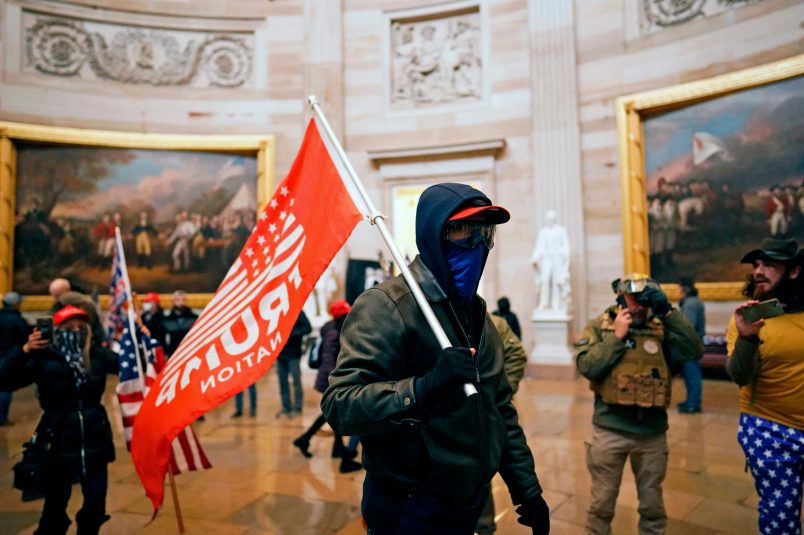The dozens of Americans arrested and charged so far for offenses related to the Capitol riot are mostly unaffiliated with existing racist or anti-government extremist groups, a new study has found.
The attack, which immediately followed a speech from then-President Donald Trump instructing his followers to “fight” and march on the Capitol, has required extremism researchers to change their thinking about far-right violence. Though some rioters were affiliated with known right-wing groups like the Oath Keepers or the Proud Boys, most were simply violent Trump supporters who have repeatedly told investigators that they came to D.C. at Trump’s request.
New data from the Chicago Project on Security and Threats (CPOST) bolsters this dynamic. Researchers combed through court documents and media reports for all 193 people who’d been charged, as of last week, with entering the Capitol building or breaking through barriers to enter the Capitol grounds. They compared that group with right-wing extremists arrested for deadly violence between 2015 and 2020, a set of 108 people.
What emerged, two members of the research team wrote in The Atlantic Tuesday, was a picture of “a new kind of violent mass movement in which more ‘normal’ Trump supporters—middle-class and, in many cases, middle-aged people without obvious ties to the far right—joined with extremists in an attempt to overturn a presidential election.”
Among other notable data: Capitol arrestees are older on average than the violent right-wing extremists arrested between 2015 and 2020. They’re also more employed: Just 9% are unemployed compared to 25% of the 2015–20 group. Many are business owners.
Organized extremist groups were certainly present and involved at the Capitol. Members of the Proud Boys and Oath Keepers now face serious conspiracy charges for their actions, and more such charges are likely forthcoming.
But, of the group formally accused of breaching the Capitol as of last week, the Chicago researchers found that a full 89% were unaffiliated with existing right-wing extremist groups.
That stands in contrast to the extremist arrestees from the past five years that the group studied; a majority of those had ties to either extremist groups or gangs.
The researchers wrote that the Capitol riot revealed a new force in American politics, “a broader mass political movement that has violence at its core.”
The conclusions researchers can draw at this stage are still limited. Federal authorities are in the early weeks of their investigation into the Capitol incident, and they’ve said that they picked off easier cases first, such as people who shared photos of themselves breaking the law on social media.
By contrast, right-wing extremists arrested for deadly violence between 2015 and 2020 were in some cases under the federal microscope for months or years.
And, of course, Trump advertised the Capitol rally for weeks in advance, beckoning his supporters to the nation’s capital by promising a speech and hyping a confrontation with Congress. That goes some way toward explaining the Trump superfans’ presence.
Still, the Chicago team isn’t alone in distinguishing the Capitol rioters from the right-wing extremists who researchers have tracked for years.
“Emerging from the post-Trump political landscape is a bloc best described as the anti-democratic hard right: one that wants to purge the current political order and endorses an authoritarian form of government that maintains and strengthens existing social stratification,” researchers at the Southern Poverty Law Center wrote last month.
Mark Pitcavage, a senior research fellow at the Anti-Defamation League’s Center on Extremism, told TPM last month that the Capitol riot represented “the culmination of something that has been developing for some time: a new extremist movement, centered around the cult of personality of Trump.”
Concluding an overview of their findings, the CPOST researchers noted that responding to the Capitol attack isn’t as simple as cracking down on extremist groups.
“Targeting pre-2021 far right organizations alone will not solve the problem,” they wrote. “Political violence coming from a new mass movement requires new political solutions.”







“most were simply violent Trump supporters who have repeatedly told investigators that they came to D.C. at Trump’s request.”
How Randall Flagg-ish of Trump.
Flat Earthers with rocks for brains.
I thought they were Republicans.
Their being unaffiliated suggests that they could be more dangerous and lethal because they cannot be identified with a known group, i.e. their motivations for future violence is hard, if not impossible, to trace.
Beat me to it!